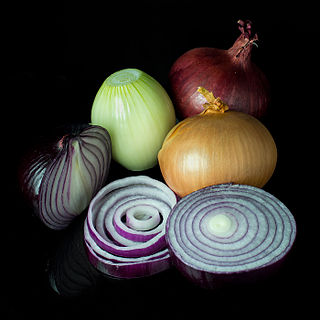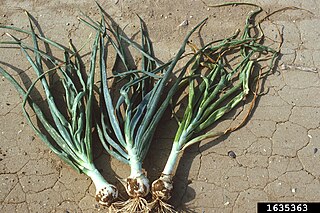
An onion, also known as the bulb onion or common onion, is a vegetable that is the most widely cultivated species of the genus Allium. The shallot is a botanical variety of the onion which was classified as a separate species until 2011. Its close relatives include garlic, scallion, leek, and chive.

Brassinosteroids are a class of polyhydroxysteroids that have been recognized as a sixth class of plant hormones and may have utility as anticancer drugs for treating endocrine-responsive cancers by inducing apoptosis of cancer cells and inhibiting cancerous growth. These brassinosteroids were first explored during the 1970s when Mitchell et al. reported promotion in stem elongation and cell division by the treatment of organic extracts of rapeseed pollen. Brassinolide was the first brassinosteroid to be isolated in 1979, when pollen from Brassica napus was shown to promote stem elongation and cell divisions, and the biologically active molecule was isolated. The yield of brassinosteroids from 230 kg of Brassica napus pollen was only 10 mg. Since their discovery, over 70 BR compounds have been isolated from plants.

The apoplast is the extracellular space outside of plant cell membranes, especially the fluid-filled cell walls of adjacent cells where water and dissolved material can flow and diffuse freely. Fluid and material flows occurring in any extracellular space are called apoplastic flow or apoplastic transport. The apoplastic pathway is one route by which water and solutes are transported and distributed to different places through tissues and organs, contrasting with the symplastic pathway.

Plant anatomy or Phytotomy is the general term for the study of the internal structure of plants. Originally it included plant morphology, the description of the physical form and external structure of plants, but since the mid-20th century plant anatomy has been considered a separate field referring only to internal plant structure. Plant anatomy is now frequently investigated at the cellular level, and often involves the sectioning of tissues and microscopy.

The leek moth or onion leaf miner is a species of moth of family Acrolepiidae and the genus Acrolepiopsis. The species is native to Europe and Siberia, but is also found in North America, where it is an invasive species. While it was initially recorded in Hawaii, this was actually a misidentification of Acrolepiopsis sapporensis.
Pea seed-borne mosaic virus (PSbMV) is a plant pathogenic virus of the family Potyviridae.

The exodermis is a physiological barrier that has a role in root function and protection. The exodermis is a membrane of variable permeability responsible for the radial flow of water, ions, and nutrients. It is the outer layer of a plant's cortex. The exodermis serves a double function as it can protect the root from invasion by foreign pathogens and ensures that the plant does not lose too much water through diffusion through the root system and can properly replenish its stores at an appropriate rate.

Randy O. Wayne is an associate professor of plant biology at Cornell University. Along with his former colleague Peter K. Hepler, Wayne established the role of calcium in regulating plant growth. Their 1985 article Calcium and Plant Development was awarded the "Citation Classic" award from Current Contents magazine. They researched how plant cells sense gravity through pressure, the water permeability of plant membranes, light microscopy, as well as the effects of calcium on plant development. Wayne authored two textbooks, including Plant Cell Biology: From Astronomy to Zoology and Light and Video Microscopy.
The Melanotaenium is a genus of smut fungi in the family Melanotaeniaceae.

Quercetin 3,4'-diglucoside is a flavonol glycoside found in onions and in horse chestnut seeds.
Masashi Tazawa is a botanist, notable for his physiological, biophysical and cell biological research on characean cells. He is a member of the Botanical Society of Japan, a corresponding member of the American Society of Plant Physiologists, and an honorary member of the German Botanical Society. Tazawa is also an honorary member of The Botanical Society of Japan and also an honorary member of the Japanese Society of the Plant Physiologists. In 1990. Tazawa received the Japan Academy Prize. In 1990/91 he was president of the Japanese Society of Plant Physiologists, and from 1976 to 1981, he was secretary of the Japanese Society of Cell Biology.

Peter Klock Hepler HonFRMS is the Constantine J. Gilgut and Ray Ethan Torrey Professor Emeritus in the Biology Department of the University of Massachusetts at Amherst who is notable for his work on elucidating the roles of calcium, membranes and the cytoskeleton in plant cell development and cell motility.
Janet Quentin Plowe was a biologist credited for helping to discover the cell membrane.

Onion yellow dwarf virus (OYDV) is a plant virus in the genus Potyvirus that has been identified worldwide and mainly infects species of Allium such as onion, garlic, and leek. The virus causes mild to severe leaf malformation, and bulb reduction up to sixty percent has been observed in garlic.
Eva Konrad Hawkins was a Hungarian-born American biologist and college professor.
Garlic common latent virus (GarCLV) is a plant virus member of the genus Carlavirus that has been found infecting garlic globally. Detection of the virus in leek and onion has also been reported.
Shallot latent virus (SLV), a species of Carlavirus, was first identified in shallots in Netherlands. The virus particle is elongated, 650 nm in length.
Rosalie Auguste Emma Wunderlich was an Austrian botanist and embryologist at the University of Vienna.
Margaret Elizabeth McCully is a Canadian botanist and cell biologist, known as one of the world's leading experts on plant root structure. In 1996 the Canadian Botanical Association awarded her the George Lawson Medal for lifetime contribution to botany. In 2015 she received the inaugural ISRR Lifetime Award from the International Society of Root Research.










